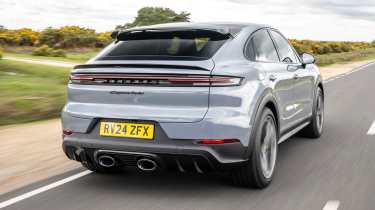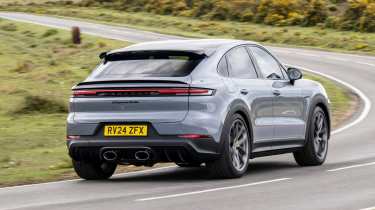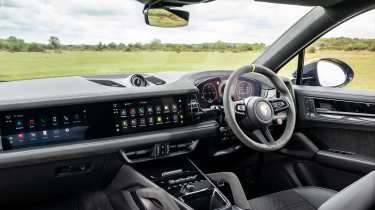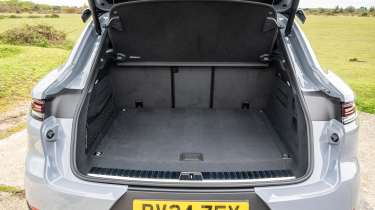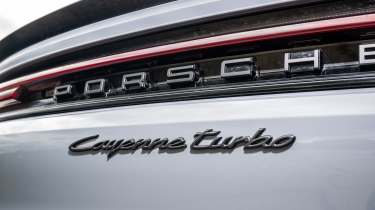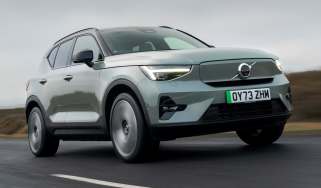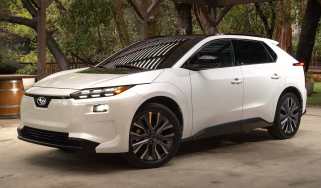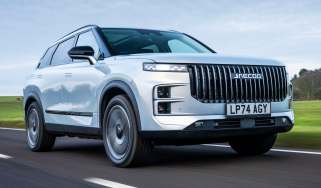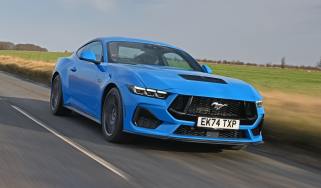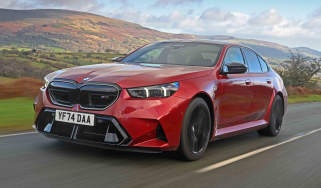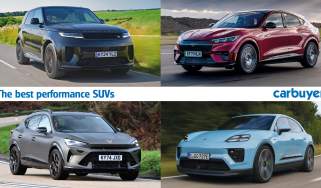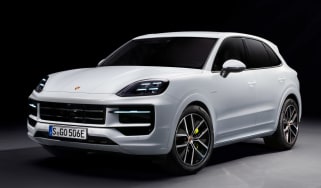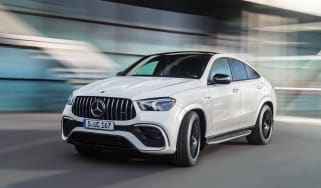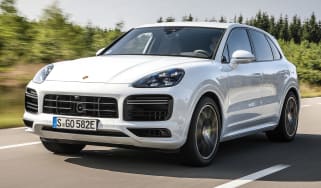Porsche Cayenne Coupe review - less practical, even more fun
"The Porsche Cayenne Coupe trades a little practicality for a sportier exterior look"
Pros
- Huge performance
- Excellent handling
- Easy to live with
Cons
- Expensive to run
- Reduced practicality
- Expensive options
Verdict – is the Porsche Cayenne Coupe a good car?
The Porsche Cayenne Coupe is a version of the popular Cayenne SUV that has a more sloped roof at the back, which gives it a sporty look but a bit less boot space. It’s a rival for similar models from premium car makers including the BMW X6, Mercedes GLE Coupe and even the Lamborghini Urus. The result is one of the absolute best SUVs on the market for keen drivers, with incredible performance and handling. For keen drivers, we’d avoid the top-spec Turbo E-Hybrid if it were our money – the GTS feels purer to drive and better value, as it costs £60k less.
Porsche Cayenne Coupe models, specs and alternatives
There are a few other changes to the exterior that give the Cayenne Coupe a sportier look than the regular version, but from the front, you’d be hard-pressed to tell them apart – and from the inside, it’s only apparent from the slightly lower roof in the back. The Cayenne range, including the Coupe, was updated in 2023 with slimmer matrix LED lights and some other small changes to keep it up-to-date.
 Best luxury SUVs to buy in 2025
Best luxury SUVs to buy in 2025
The mechanical parts under the skin are pretty much identical. The top-spec Cayenne Turbo E-Hybrid model goes from 0-62mph in just 3.7 seconds and up to a 183mph top speed, the same as in the normal Cayenne. However, there’s also a GT Package available only for the Coupe model, which brings some improvements for enthusiast drivers and drops the 0-62mph time to just 3.6 seconds.
More reviews
Along with the Turbo E-Hybrid, which uses a 4.0-litre V8 petrol engine alongside its electric motors, there’s the Cayenne E-Hybrid Coupe, which has a V6 petrol engine with 464bhp when combined with its electric motors, and the Cayenne S E-Hybrid, which has the same set-up but with 512bhp.
These plug-in hybrid models are the most economical models in the range and can drive for around 45 miles on a full battery without the engine even coming on. Charge up regularly and you could even see over 150mpg according to official figures.
The base model in the Cayenne range has 348bhp and goes from 0-62mph in 5.7 seconds, so even at the entry-point to Cayenne ownership, there’s plenty of performance available.
Then there’s the Cayenne S Coupe, which has 468bhp and goes from 0-62mph in 4.7 seconds. Both these models are petrol only, they can’t be plugged in. Our pick of the range if you’re a keen driver is the GTS, which may have less power than the plug-in hybrid Turbo E-Hybrid, but feels sharper to drive and is the most hardcore of the pure petrols – it’s also almost £60k cheaper than the top-spec E-Hybrid Coupe with GT package.
The Cayenne Coupe’s handling puts it top of the SUV pile - even if it’s not noticeably better than the standard Cayenne - with a clever rear-wheel steering setup that allows the Porsche to feel like a car half its size.
Practicality suffers slightly compared with the standard Cayenne because of the change in shape. You won't notice any change in the front of the car but the three rear seats have been changed to two, and headroom takes a hit. Boot space drops by 145 litres, although that still leaves a sizeable 600 litres to play with.
MPG, running costs & CO2
The Cayenne Coupe has been designed to be a high-performance, luxury SUV first and foremost, so it was never likely to be cheap to run. That's especially the case now Porsche has stopped selling diesel versions, which tended to be more economical on longer trips.
Considering the steps up in performance, each conventional version of Cayenne Coupe will cost a surprisingly similar amount to run. Fuel economy figures for the Cayenne Coupe range from around 21mpg to 26mpg in the petrol-only versions. These models also emit from 247g/km of CO2, so they’re very expensive to run for company-car buyers to tax. The plug-in hybrid models are much more affordable to run, although they cost more to buy.
The Cayenne E-Hybrid emits as little as 33g/km of CO2 and claimed fuel economy is 156.9 to 188.3mpg, and these figures hardly change through the range of plug-in models up to the Cayenne Turbo E-Hybrid with GT Package, which emits 40g/km of CO2 and returns around 150mpg as well. This is all down to the electric motors, which perform very well on the official tests.
In reality, the 4.0-litre V8 engine in the Turbo models is likely to be quite a bit less economical than the V6 in the lesser hybrid versions, although unless you plug in regularly and make use of the 45 miles of driving range on electric power alone, no model in the Cayenne Coupe range will be cheap to run.
Every conventional Cayenne Coupe model is taxed at the standard VED (road tax) rate from years two to six, with the PHEV models liable for the discounted rate. As every Cayenne Coupe is over the £40,000 threshold, owners are also liable for the additional annual surcharge in the first five renewal years. You'll also need to budget for expensive Porsche servicing costs and wear items like tyres and brakes - all of which are costly to replace.
Engines, drive & performance
It's a strange world in which a new SUV that can get from 0-62mph in under four seconds doesn't make headlines, but it's today's reality thanks to the current crop of fast SUVs. The Cayenne Coupe shares some of its DNA with the Lamborghini Urus, offering much of its performance in a more restrained package, while also taking on the BMW X6 and Mercedes GLE Coupe.
While the performance statistics of the entry-level V6 sound impressive on paper, the Cayenne Coupe is still a very heavy car at 2.1 tonnes. On UK roads, it occasionally felt laboured and needed working harder than the V8 to unlock its true potential.
The top-spec Cayenne Turbo E-Hybrid Coupe is capable of 0-62mph in 3.7 seconds and has a top speed of 190mph. It uses a 4.0-litre twin-turbocharged V8 with additional electric power, resulting in a total of 729bhp. We tested this model with the GT Package fitted, which cuts the sprint time to 3.6 seconds. This version also gets a unique setup for the air suspension which makes it 10mm lower than the other Cayenne Coupe models, along with some other tweaks to make it more agile at high speeds.
As a result the Turbo E-Hybrid with the GT package is incredibly nimble for a car of its size and weight, with barely any body roll and unbelievable levels of grip. There’s lots of feedback through the steering wheel and the steering itself feels very precise.
Because it’s a plug-in hybrid, the range-topper can also be very refined and civilised when you set off – it starts up in complete silence, but touch the Sport or Sport Plus modes and the V8 engine awakes from its slumber and makes itself known with a snarl.
There is a catch though; although the Turbo E-Hybrid is undoubtedly quick and impressively agile, there’s no getting past the fact that its plug-in hybrid system makes it feel heavy when braking and through the corners – it’s actually slower than the old Turbo GT from 0-62mph by half a second. We think you’d be better off with the Coupe GTS which feels purer and sharper to drive, yet costs almost £60k less.
If you still want a plug-in hybrid model for extra versatility there’s the base E-Hybrid Coupe producing 464bhp from a 3.0-litre V6 petrol engine and an electric motor. Its performance is comparable with the conventional S model, with a 0-62mph time of 4.9 seconds and a top speed of 158mph.
When running in electric mode, the hybrid Cayenne Coupe models are refined and cruise in near-silence. With 45 miles of driving range, they’re also able to cover most people’s daily driving duties with ease on electric power alone. When the petrol engine kicks in, it combines with the electric motor to deliver savage straight-line speed and thanks to the Porsche’s sharp handling, all models are fun to drive as well.
Every Cayenne Coupe has clever adaptive suspension meaning there is almost no body lean and the nose of the car feels keen to turn into corners. This is helped by rear-wheel steering that can turn a few degrees to boost agility at lower speeds, making the Cayenne Coupe feel like a much smaller car. It's helped by well-tuned steering that is precise and weighty without feeling artificial.
Interior & comfort
If you want a smooth and refined Cayenne Coupe you should avoid models with the largest 22-inch alloy wheels and the optional sports suspension also makes the car less comfy. When we tried the GT Package on a smooth race track it felt great but on a bumpy, normal road you’ll probably wish you had the normal, road-focused set-up instead.
The dashboard uses Porsche's latest hardware, as seen in the latest Porsche 911, with an analogue rev gauge surrounded by digital displays that can show various different information. Sat nav and infotainment is shown on a sharp 12-inch display in the centre console and you also get a panoramic sunroof, eight-way adjustable sports seats, front and rear parking assistance and Porsche's Sport Chrono package. The Cayenne Coupe S gets additional features like Porsche Active Suspension Management (PASM), a rear-view camera and adaptive suspension as standard.
It's possible to spend a small fortune on options on every Cayenne Coupe model, with features like adaptive cruise control (£1,100), a sports exhaust (£2,200) and Dynamic Chassis Control, which lets you control the suspension stiffness using the various driving modes (£2,500).
Practicality & boot space
Around 30mm lower than the Cayenne and with four seats and a smaller boot, the Coupe clearly isn't as practical for those looking for the ultimate SUV all-rounder. However, the Cayenne Coupe is still a big car, and Porsche has lowered the rear seats to try to compensate for the reduced headroom. For no extra cost you can opt for the three rear seats from the Cayenne if you need the extra practicality.
The raked rear window reduces boot space by 145 litres compared with the standard Cayenne, so you now get 600, which is still likely to be plenty for most owners. It beats the 580 litres of the BMW X6, while the Mercedes GLE Coupe offers 650 litres.
Reliability & safety
Porsche has a reputation for building tough cars and they're backed up by a three-year/unlimited-mileage warranty, with European roadside assistance thrown in for good measure. The prestige of the Porsche badge and a strong reliability record helps boost residual values, but only when the car has been well maintained and serviced at a dealership.
Porsche came in first place overall in the 2022 and 2023 Driver Power customer satisfaction survey manufacturer’s poll, but dropped to fourth in 2024. Those are impressive results that show owners are massively impressed with the brand’s reliability and ownership experience. Premium brands often fail to meet high expectations from their customers but Porsche’s consistently high placing in the survey bucks this trend.
It's also reassuring to know the Cayenne shares its platform with the Audi Q8 and Volkswagen Touareg, so all the latest crash-avoidance and safety kit is available. Some of these are expensive options in the Porsche, however, so it's important to choose the driving aids and safety technology you want carefully.
Which Is Best?
Cheapest
- Name5dr Tiptronic S
- Gearbox typeSemi-auto
- RRP£84,895
Most Economical
- NameE-Hybrid 5dr Tiptronic S
- Gearbox typeSemi-auto
- RRP£90,245
Fastest
- NameTurbo E-Hybrid 5dr Tiptronic S [GT Package]
- Gearbox typeSemi-auto
- RRP£166,745
